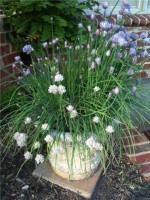The culinary herb, chives, is a bulb-forming herbaceous perennial native to temperate areas of Europe, Asia, and North America. It is a member of the Amaryllis family, Amaryllidaceae , and a close relative of onion, shallots, garlic and leek. The dark gray-green, grass-like leaves are hollow and grow about 12″ tall. The pale-purple, 6 petaled flowers are star-shaped, 1/2-3/4″ wide, and appear in dense terminal globose umbels of 10-30 on scapes well above the foliage from spring to early summer. The edible flowers can be as a garnish, in salads, as well as in both fresh and dried arrangements. A clump can be brought inside in a pot and placed in a sunny window for winter time use in cooking. The French consider chives one of the fines herbes along with tarragon, chervil and/or parsley and cooks use them to enhance almost any food except sweets. The (mild) onion flavor, however, is not to the liking of cats or insect pests and the plants can be used as companion plants to ward off pests like Japanese beetles. The fine foliage is attractive as an edging. The genus name, Allium, is the classical Latin name for garlic. The specific epithet, schoenoprasum, comes from the Greek words schoinos meaning rush, and prason meaning leek referring tothe appearance of the leaves.
Type: Perennial bulb.
Bloom: Pink or lavender ball-like blossoms in spring.
Leaves: Gray-green, very slender, cylindrical, and hollow.
Size: 12-20” H x 8-12” W.
Light: Prefers full sun but tolerates part shade.
Soil: Organically rich, moist, well drained.
Fertilizer: Apply a mild organic fertilizer like bloodmeal twice during the growing season if necessary.
Hardiness: Zones 3-8.
Care: Clumps should be divided every 3 years to ensure flowering. Clumps brought indoors for the winter need a cold period of a couple of months to produce new leaves in spring so leave part of your clump for next season’s crop
Pests and Diseases: None; in fact, chives may act as an insect repellent in some cases.
Propagation: Division; seed.

